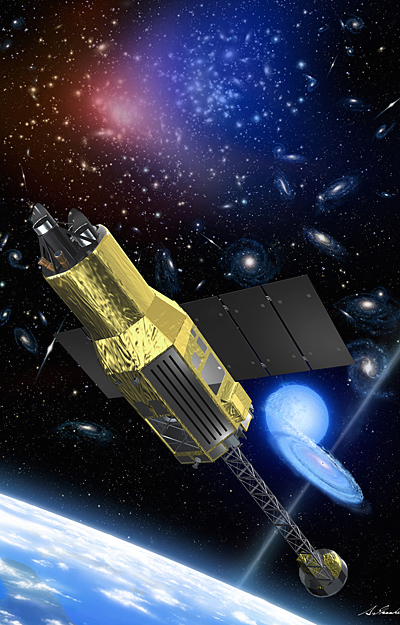An international team of astronomers has found a new explanation for enigmatic X-rays in clusters of galaxies, the largest bound objects in the Universe. These X-rays, at very specific energies, may come from an electric charge exchange between cold hydrogen gas and bare sulphur ions. Previously these X-rays were attributed to sterile neutrinos, a possible form of dark matter. The new charge exchange model offers a more natural and less exotic explanation for these X-rays. The research results appear in Astronomy and Astrophysics Letters.

Astronomers think that clusters of galaxies consist of 15% normal matter in the form of hot gas emitting X-rays. 85% is thought to be invisible dark matter. The origin and composition of this dark matter is unknown. In one of the models for dark matter so-called sterile neutrinos can decay by also emitting X-rays. The energy of these X-rays from sterile neutrinos is unknown, however. Scientists have attempted to comb through X-ray spectra of clusters to find a signal that cannot be explained by X-rays from the hot gas. Last year two groups reported to have seen such an unidentified X-ray feature at an energy of 3.5 kilovolt energy. If confirmed, this could be a major breakthrough in solving the dark matter puzzle.
“However, in addition to hot gas, some clusters also contain substantial amounts of cold gas,” says SRON-researcher and first author Liyi Gu. “Most of the cold gas comes in the form of hydrogen atoms. When such a cold atom collides with an ion from the hot gas, the electron of the hydrogen atom can jump over to the ion and produce an X-ray photon. If the ion is a bare sulphur ion (a sulphur atom ripped of all its electrons, ed.), the radiation occurs at precisely 3.5 kilovolt energy. The required amount of hot and cold gas in clusters is sufficient to produce a signal as strong as the one suggested to originate from sterile neutrinos.”

ASTRO-H
This novel, but less exotic interpretation of charge exchange, a process measured routinely in the laboratory, can be tested further by ASTRO-H, a satellite that will be launched in early 2016 by Japan. SRON-researcher Jelle Kaastra: “Astro-H has an X-ray detector with an unprecedented sensitivity for diffuse emission at 3.5 keV. In fact SRON started developing a charge exchange model in order to be ready for ASTRO-H.”
The model Liyi Gu and his colleagues at SRON developed makes use of the charge exchange calculations of Patrick Mullen, undergraduate student in the group of Phillip Stancil at the University of Georgia in the US. ASTRO-H is expected to find diffuse charge exchange emission in many different sources, including Jupiter, comets, the interstellar medium and clusters of galaxies.
More information
The article A novel scenario for the possible X-ray line feature at ~3.5 keV: charge exchange with bare sulfur ions appears today in the Astronomy & Astrophysics magazine: http://dx.doi.org/10.1051/0004-6361/201527634. Authors: Liyi Gu (SRON), Jelle Kaastra(SRON, Leiden University), Ton Raassen (SRON, University of Amsterdam), P. D. Mullen, R. S. Cumbee, D. Lyons en P. C. Stancil (all University of Georgia).


